Human-reindeer systems between steppe and taiga
The archaeological footprint of mobile hunter-reindeer herders in Northern Mongolia
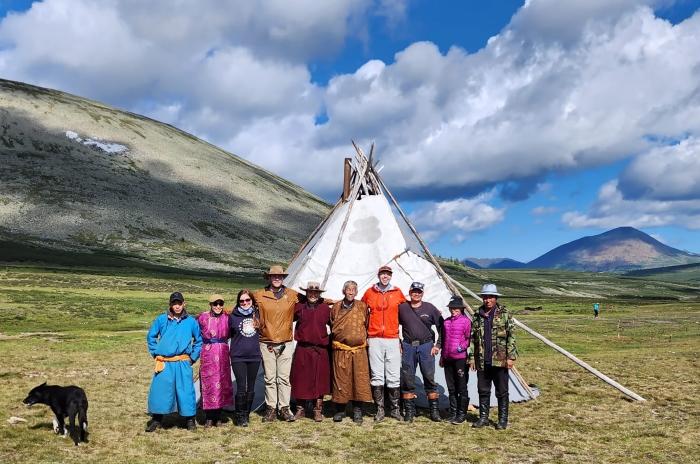
Fig. 1. The Dukha, Mongolian, US-American und German team in front of an orts tent during fieldwork in the Baruun taiga, Northern Mongolia, in summer 2023.
Project team (FU):
Prof. Dr. Henny Piezonka, Institut für Prähistorische Archäologie
Hans Whitefield, Field & Finds Lab, Institut für Prähistorische Archäologie
Cooperation partners:
Dr. Jamsranjav Bayarsaikhan, Max Planck Institute of Geoanthropology, Jena, Germany & Mongolian Academy of Science, Mongolia
Prof. Dr. Donatas Brandišauskas, Vilnius Univeristy, Lithuania
Dr. Julia Clark, NOMAD Science, USA
Dr. Jennifer M. Farquhar, University of Pittsburgh, USA
Tuvshinjargal Tumurbaatar, Mongolian Academy of Sciences, Mongolia
Prof. Dr. William Taylor, University of Colorado, Boulder, USA
Morgan Windle, Victoria, Canada
Ochiroo Yadam, Tsagaannuur, Mongolia
Ariunzul Gantulga & Ryan Kertanis (SEEK Travel, project logistics and translation)
Project duration: 2023-2025 (funded period)
Funding:
DFG, Programme „Initiation of an international cooperation” (project no. 695799)
Freie Universität Berlin, programme START (2024)
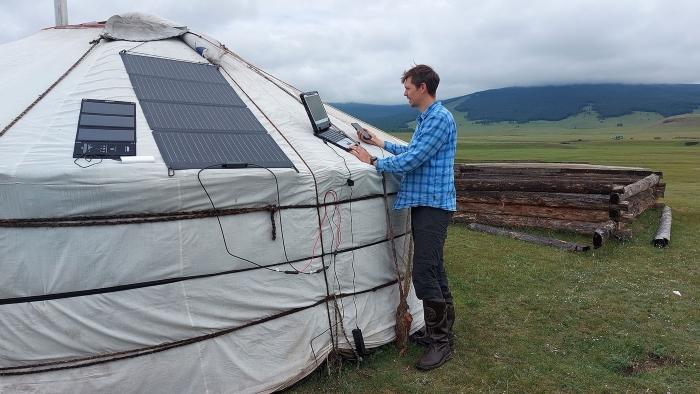
Fig. 2. Hans Whitefield preparing survey equipment before leaving on horseback into the mountains to the Dukha summer pastures, summer 2023 (photo: Henny Piezonka, FU).
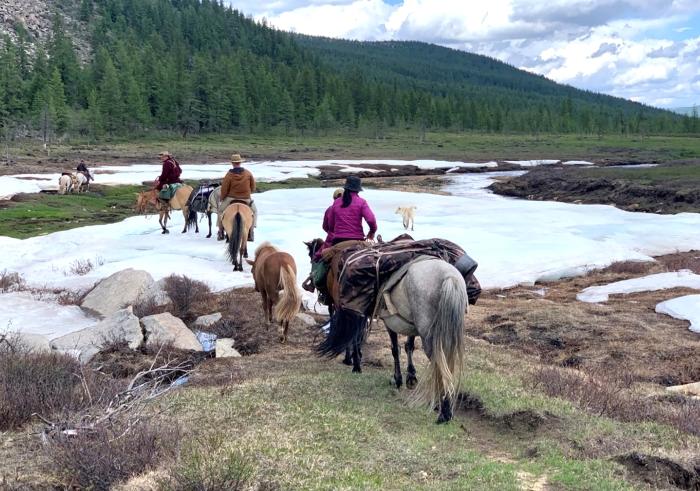
Fig. 3. The journey to the remote research area and also the movement on site takes place on horseback, as here during the 2023 expedition (photo: Hans Whitefield, FU).

Fig. 4. The Dukha use their reindeer as riding and pack animals for daily transport as well es seasonal migrations, summer 2022 (photo: Morgan Windle).
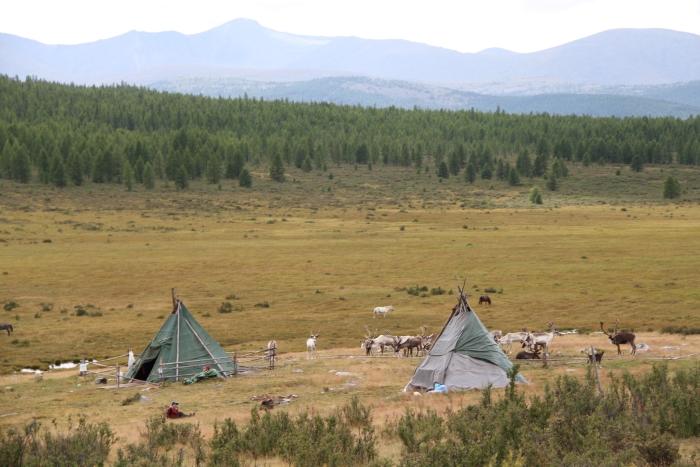
Fig. 5. The main form of housing from spring to autumn is the conical tent, comparable to North American teepees, known locally as orts in the Dukha Turkic language (photo: Tuvshinjargal Tumurbaatar, MAS).
Project description:
Background: Hunter-reindeer herders in the Mongolian mountains
In times of global warming and industrial agriculture, pastoral nomadic lifestyles are coming into focus as sustainable alternatives. Compared to other pastoral farming systems, the North and Inner Asian human-reindeer systems occupy a special place in the domestication spectrum. They rely to an unusual degree on animal agency and cross-species niche construction, including a central role of mosquitoes and other blood-sucking insects that has been largely neglected in research to date, and thus offer unique insights for a better understanding of early domestication processes. This project is a trilateral collaboration between scholars from Germany, Mongolia and the US devoted to archaeological and ethnoarchaeological research in partnership with the Dukha Indigenous community in Northern Mongolia. We develop and apply interdisciplinary comparative research to explore the role of reindeer herding in human-environmental dynamics along the steppe-forest ecotone of Inner Asia. The project builds on previous research of the work group of Henny Piezonka, Morgan Windle and Russian partners with the Sel’kup community in West Siberia (see “Previous Projects” section).
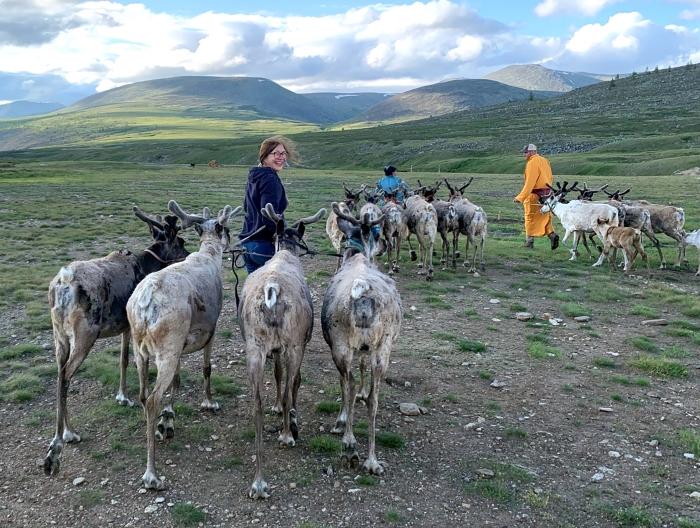
Fig. 6. In summer 2023, team members William Taylor (right) and Henny Piezonka (left) helped Dukha herders to bring their reindeer to the overnight sites during a thunderstorm (photo: Hans Whitefield, FU).
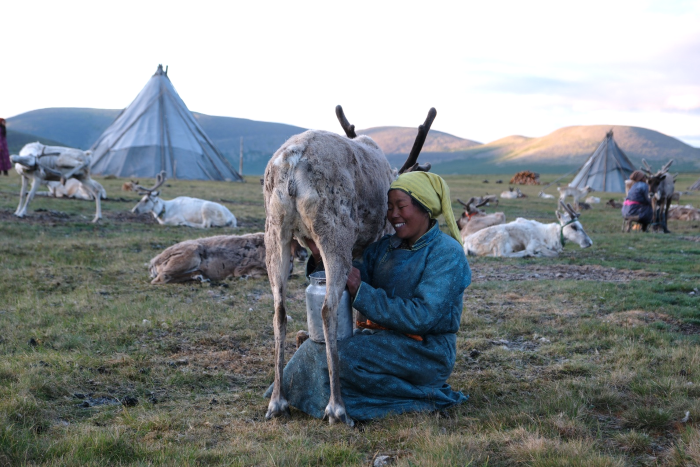
Fig. 7. Female reindeer are milked daily early in the morning. Reindeer milk and fermented dairy products make up a significant proportion of the diet (photo: Henny Piezonka, FU).
In the taiga-covered mountains east of the Darkhad basin, Khuvsgul province, Northern Mongolia, families of the Dukha community subsist largely through the herding of domestic reindeer in the alpine taiga of the Eastern Sayan Mountains, supplemented by hunting, fishing, and herding of other domestic livestock. They are part of a wider population of Turkic-speaking hunter-reindeer herder communities in the Russian-Mongolian borderzone who keep the deer for riding and milking. The location of this reindeer herding community along the margins of the steppe and the northern boreal forest places them in an important ecological and cultural role, and further study of this key lifeway, in comparison with the herding strategies at the transition between taiga and tundra in northern Siberia, holds the potential to shed new light on human-animal dynamics in both past and future.
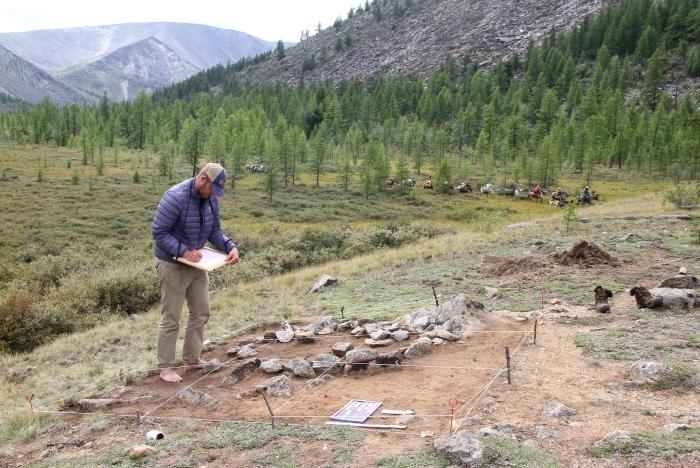
Fig. 8. Project collaborator William Taylor drawing an archaeological feature at Ovoogol, Eastern Sayan Mountains, August 2024, with Dukha reindeer caravan passing by in the background (photo: Henny Piezonka, FU).
Research questions
Our project employs a systematic comparative approach of variants of small-scale reindeer herding at the fringes of the Eurasian taiga. Assessing previous results from Western Siberia in comparison to newly generated results on North Mongolian traditional reindeer herding gained through new fieldwork, the project concentrates on the following questions: (1) What are similarities and differences in herding practices, purposes of reindeer husbandry, and associated lifeways? (2) What are reasons for the observed similarities and differences, and in what way are they related to the respective local and regional deeper histories? (3) What is the archaeological footprint of the various hunter-herder lifeways in the taiga? (4) Which impact did horse and cattle herding practices of Mongolian steppe nomads have on the emergence and type of reindeer husbandry in the North Mongolian and adjacent South Siberian human-reindeer systems, and how was it related to timing and dynamics of reindeer domestication?
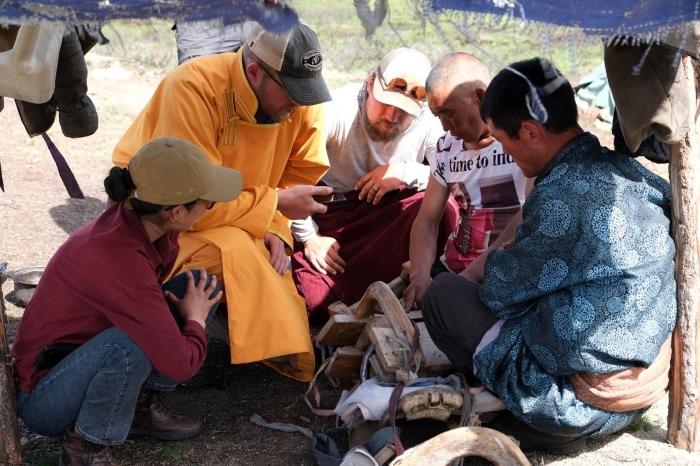
Fig. 9. William Taylor together with project coordinators Ariunzul Gantulga and Ryan Kertanis learning from Dukha experts about the specificities of the reindeer saddle, summer 2023 (photo: Henny Piezonka, FU).
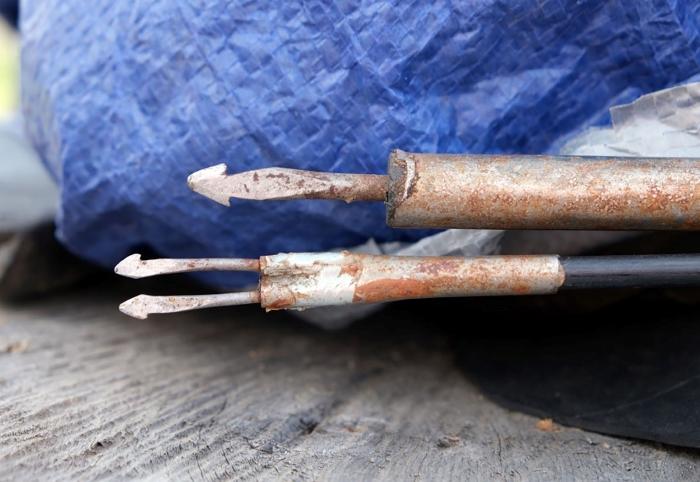
Fig. 10. Artefacts such as these fish spears made from left-over tourists’ tent poles provide insights into everyday technologies (photo: Henny Piezonka, FU).
Previous work
Previous fieldwork and zooarchaeological analysis by project partners Julia Clark, WilliamTaylor, Tuvshinjargal Tumurbaatar and their teams in the region since 2014 has established that the Darkhad basin area in Northern Mongolia followed a unique trajectory during the transition to early pastoral societies. Their fieldwork with the Dukha community revealed an important historic archaeological record linked to 20th century Dukha use of high-altitude snow and ice zones, and showed that a warming climate poses a significant threat to traditional reindeer herding practices. During NOMAD Science-led fieldwork in 2022, doctoral researcher Morgan Windle joined the team to introduce a comparative archaeozoological scope and multispecies research framework based on her previous work with Sel’kup hunter-herders further north.
Fieldwork 2023 & 2024
In 2023, we successfully applied for an initiation project from the DFG, which supported the development of German-Mongolian-American cooperation through working meetings in Berlin and Ulaanbaatar and facilitated a 7-day pilot field campaign in the working area. The team visited various Dukha summer settlements on horseback and was able to gain initial insights into the functioning of reindeer pastoralism in the region, the associated nomadic technologies and the cultural and cosmological background. We were able to document a specific, sophisticated system of daily and seasonal herd management, which in particular enables the intensive utilisation of reindeer milk. Within the frames of her dissertation, Morgan Windle and colleagues were able to identify pathological markers and skeletal asymmetries connected to reindeer riding. Numerous seasonal Dukha campsites have been documented in the landscape, and archaeological finds have also been found at some of these sites as traces of use going back into the past. These sites have great potential for further transdisciplinary research into the history, economy and ecology of the specialised reindeer-based land use in the region.

Fig. 11. The study of the dismantled remains of orts (Dukha conical tents) in the Sayan alpine valleys provide detailed ethnoarchaeological insights into spatial structure and material footprint of nomadic dwellings in these environments (photo: Henny Piezonka, FU).
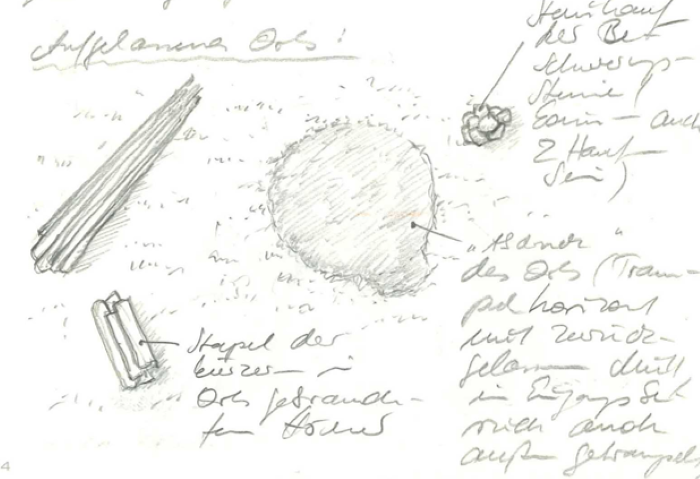
Fig. 12. The drawing shows an example recorded in summer 2023 at Menge Bulag alpine valley (sketch: field diary Henny Piezonka, FU).
The second field campaign, funded through the START programme of Freie Universität Berlin, built on the findings of the project team's preliminary work and in particular on the results and contacts from the 2023 summer expedition. At strategically interesting settlement sites in the working area, which had previously only been documented above ground, the character of the archaeological finds precipitation there was examined by means of surveys and small excavation sections. The investigations centred on a spur of land above a river course in the Ovoogol mountain valley, where we assumed repeated use from the Stone Age to the present day based on the surface finds. The excavation cut was made at the site of an ortz site, probably several decades old, in order to record the archaeological footprint of such a dwelling tent. Older hearth pits and activity zones were found in the underlying layers, some of which could be prehistoric according to the finds - 14C dating is currently in progress.

Fig. 13. Prehistoric stone artefacts from Ovoogol, summer 2023: An archaeological veil of finds on today's settlement sites provides evidence of thousands of years of land use by mobile groups (photo and drawings: Henny Piezonka, FU).
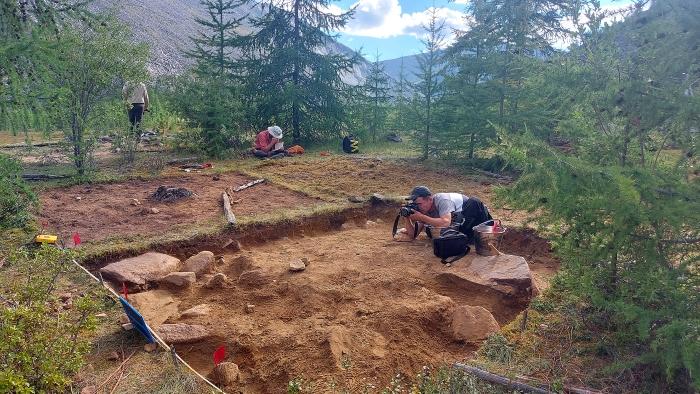
Fig. 14. At Ovoogol, we examined a several decades old orts site and the underlying older, possibly prehistoric layers. Project partner Tuvshinjargal Tumurbaatar documented the profiles, summer 2024 (photo: Morgan Windle).
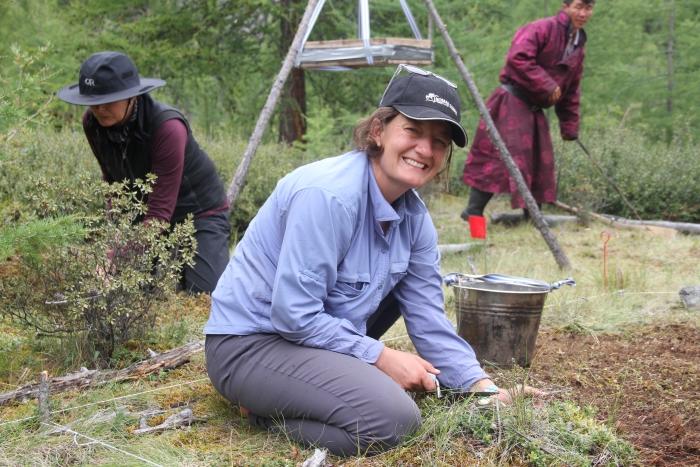
Fig. 15. Project partner Julia Clark directed a team of students and volunteers at the excavation of Ovoogol, summer 2024 (photo: Henny Piezonka, FU).
Outlook
The project is ongoing, first results have been published, and analysis of further data and information is currently under way. Fieldwork will continue in 2025 and we envisage continuation of this research through larger projects in the future.
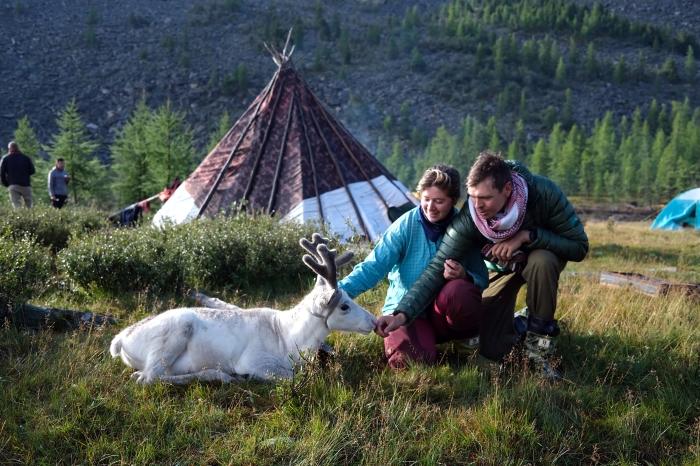
Fig. 16. Team members Morgan Windle (who successfully defended her dissertation on North Eurasian human-reindeer systems in 2025 at CAU Kiel) and Hans Whitefield greeting a visitor in the Ovoogol expedition camp, summer 2024 (photo: Henny Piezonka, FU).
Publications:
Windle, M., Pleuger-Dreibrodt, S., Clark, J.K., Bayarsaikhan, J., Taylor, W.T.-T., Piezonka, H., accepted. Multispecies entanglements and stable isotope signals (δ13C and δ15N) in modern reindeer-herding communities of boreal Northeast Asia. Philos. Trans. R. Soc. B Biol. Sci.
Windle, M., Tumurbaatar, T., Zhang, C., Li, Y., Brandišauskas, D., Piezonka, H., Yadam, O., Gantulga, A., Kertanis, R., Taylor, W., accepted. Understanding the origin of reindeer riding in Northeast Asia through animal 1 paleopathology and collaborative archaeology. Arct. Antarct. Alp. Res.
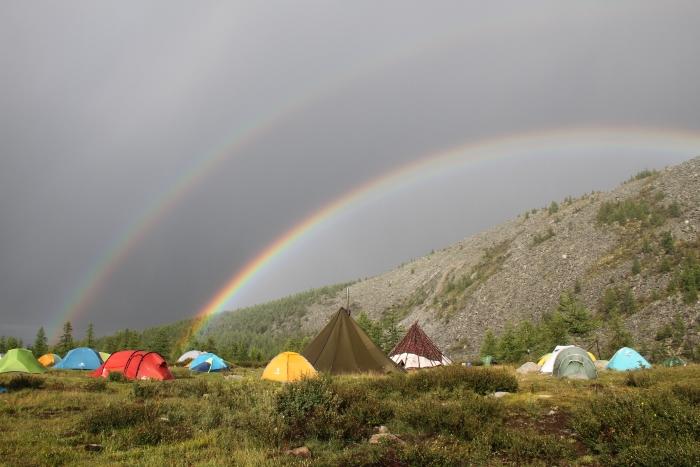
Fig. 17. Evening at Ovoogol expedition camp, summer 2024 (photo: Tuvshinjargal Tumurbaatar, MAS).

